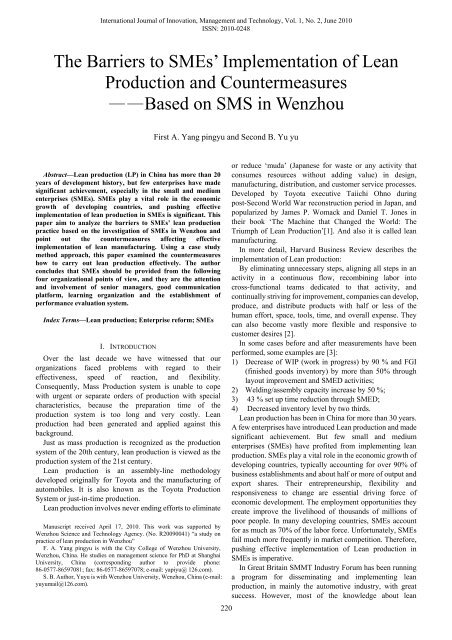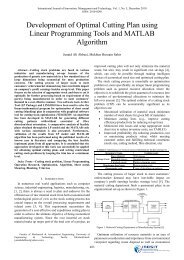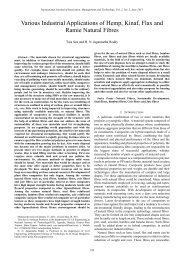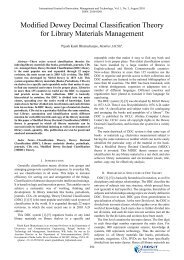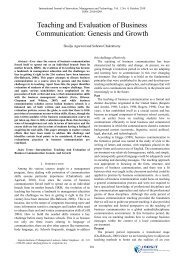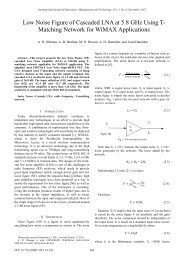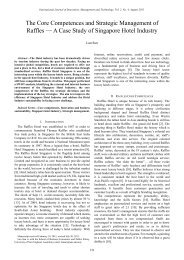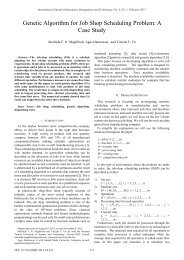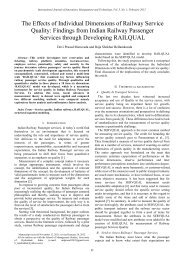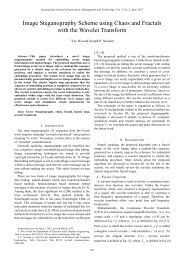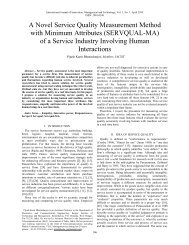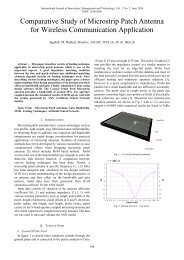The Barriers to SMEs' Implementation of Lean Production and ... - ijimt
The Barriers to SMEs' Implementation of Lean Production and ... - ijimt
The Barriers to SMEs' Implementation of Lean Production and ... - ijimt
Create successful ePaper yourself
Turn your PDF publications into a flip-book with our unique Google optimized e-Paper software.
International Journal <strong>of</strong> Innovation, Management <strong>and</strong> Technology, Vol. 1, No. 2, June 2010ISSN: 2010-0248<strong>The</strong> <strong>Barriers</strong> <strong>to</strong> SMEs’ <strong>Implementation</strong> <strong>of</strong> <strong>Lean</strong><strong>Production</strong> <strong>and</strong> Countermeasures——Based on SMS in WenzhouFirst A. Yang pingyu <strong>and</strong> Second B. Yu yuAbstract—<strong>Lean</strong> production (LP) in China has more than 20years <strong>of</strong> development his<strong>to</strong>ry, but few enterprises have madesignificant achievement, especially in the small <strong>and</strong> mediumenterprises (SMEs). SMEs play a vital role in the economicgrowth <strong>of</strong> developing countries, <strong>and</strong> pushing effectiveimplementation <strong>of</strong> lean production in SMEs is significant. Thispaper aim <strong>to</strong> analyze the barriers <strong>to</strong> SMEs’ lean productionpractice based on the investigation <strong>of</strong> SMEs in Wenzhou <strong>and</strong>point out the countermeasures affecting effectiveimplementation <strong>of</strong> lean manufacturing. Using a case studymethod approach, this paper examined the countermeasureshow <strong>to</strong> carry out lean production effectively. <strong>The</strong> authorconcludes that SMEs should be provided from the followingfour organizational points <strong>of</strong> view, <strong>and</strong> they are the attention<strong>and</strong> involvement <strong>of</strong> senior managers, good communicationplatform, learning organization <strong>and</strong> the establishment <strong>of</strong>performance evaluation system.Index Terms—<strong>Lean</strong> production; Enterprise reform; SMEsI. INTRODUCTIONOver the last decade we have witnessed that ourorganizations faced problems with regard <strong>to</strong> theireffectiveness, speed <strong>of</strong> reaction, <strong>and</strong> flexibility.Consequently, Mass <strong>Production</strong> system is unable <strong>to</strong> copewith urgent or separate orders <strong>of</strong> production with specialcharacteristics, because the preparation time <strong>of</strong> theproduction system is <strong>to</strong>o long <strong>and</strong> very costly. <strong>Lean</strong>production had been generated <strong>and</strong> applied against thisbackground.Just as mass production is recognized as the productionsystem <strong>of</strong> the 20th century, lean production is viewed as theproduction system <strong>of</strong> the 21st century.<strong>Lean</strong> production is an assembly-line methodologydeveloped originally for Toyota <strong>and</strong> the manufacturing <strong>of</strong>au<strong>to</strong>mobiles. It is also known as the Toyota <strong>Production</strong>System or just-in-time production.<strong>Lean</strong> production involves never ending efforts <strong>to</strong> eliminateManuscript received April 17, 2010. This work was supported byWenzhou Science <strong>and</strong> Technology Agency. (No. R20090041) “a study onpractice <strong>of</strong> lean production in Wenzhou”F. A. Yang pingyu is with the City College <strong>of</strong> Wenzhou University,Wenzhou, China. He studies on management science for PhD at ShanghaiUniversity, China (corresponding author <strong>to</strong> provide phone:86-0577-86597081; fax: 86-0577-86597078; e-mail: yapiyu@ 126.com).S. B. Author, Yuyu is with Wenzhou University, Wenzhou, China (e-mail:yuyumail@126.com).220or reduce ‘muda’ (Japanese for waste or any activity thatconsumes resources without adding value) in design,manufacturing, distribution, <strong>and</strong> cus<strong>to</strong>mer service processes.Developed by Toyota executive Taiichi Ohno duringpost-Second World War reconstruction period in Japan, <strong>and</strong>popularized by James P. Womack <strong>and</strong> Daniel T. Jones intheir book ‘<strong>The</strong> Machine that Changed the World: <strong>The</strong>Triumph <strong>of</strong> <strong>Lean</strong> <strong>Production</strong>’[1]. And also it is called leanmanufacturing.In more detail, Harvard Business Review describes theimplementation <strong>of</strong> <strong>Lean</strong> production:By eliminating unnecessary steps, aligning all steps in anactivity in a continuous flow, recombining labor in<strong>to</strong>cross-functional teams dedicated <strong>to</strong> that activity, <strong>and</strong>continually striving for improvement, companies can develop,produce, <strong>and</strong> distribute products with half or less <strong>of</strong> thehuman effort, space, <strong>to</strong>ols, time, <strong>and</strong> overall expense. <strong>The</strong>ycan also become vastly more flexible <strong>and</strong> responsive <strong>to</strong>cus<strong>to</strong>mer desires [2].In some cases before <strong>and</strong> after measurements have beenperformed, some examples are [3]:1) Decrease <strong>of</strong> WIP (work in progress) by 90 % <strong>and</strong> FGI(finished goods inven<strong>to</strong>ry) by more than 50% throughlayout improvement <strong>and</strong> SMED activities;2) Welding/assembly capacity increase by 50 %;3) 43 % set up time reduction through SMED;4) Decreased inven<strong>to</strong>ry level by two thirds.<strong>Lean</strong> production has been in China for more than 30 years.A few enterprises have introduced <strong>Lean</strong> production <strong>and</strong> madesignificant achievement. But few small <strong>and</strong> mediumenterprises (SMEs) have pr<strong>of</strong>ited from implementing leanproduction. SMEs play a vital role in the economic growth <strong>of</strong>developing countries, typically accounting for over 90% <strong>of</strong>business establishments <strong>and</strong> about half or more <strong>of</strong> output <strong>and</strong>export shares. <strong>The</strong>ir entrepreneurship, flexibility <strong>and</strong>responsiveness <strong>to</strong> change are essential driving force <strong>of</strong>economic development. <strong>The</strong> employment opportunities theycreate improve the livelihood <strong>of</strong> thous<strong>and</strong>s <strong>of</strong> millions <strong>of</strong>poor people. In many developing countries, SMEs accountfor as much as 70% <strong>of</strong> the labor force. Unfortunately, SMEsfail much more frequently in market competition. <strong>The</strong>refore,pushing effective implementation <strong>of</strong> <strong>Lean</strong> production inSMEs is imperative.In Great Britain SMMT Industry Forum has been runninga program for disseminating <strong>and</strong> implementing leanproduction, in mainly the au<strong>to</strong>motive industry, with greatsuccess. However, most <strong>of</strong> the knowledge about lean
International Journal <strong>of</strong> Innovation, Management <strong>and</strong> Technology, Vol. 1, No. 2, June 2010ISSN: 2010-0248production is tied up in larger companies <strong>and</strong>consultant/research ac<strong>to</strong>rs <strong>and</strong> has not been spread widely <strong>to</strong>SMEs companies.In Wenzhou, a coastal open city, private enterprise iswell-developed, <strong>and</strong> most <strong>of</strong> them participate in internationalcompetition. In order <strong>to</strong> minimize the gap <strong>to</strong> the matureenterprises in developed countries or collaborate with them,many big private enterprises in Wenzhou have introductionlean production. CHINT Company, an electric industryleading enterprises in Wenzhou, has pioneered the reform <strong>of</strong>lean production. East Art Company the largest footwearforeign trade companies in Wenzhou also introduced <strong>Lean</strong><strong>Production</strong> in 2005. And Aokang, Kangnai <strong>and</strong> otherlarge-scale enterprises have begun the reform <strong>of</strong> leanproduction. But the concept <strong>of</strong> lean production is stillrelatively new <strong>to</strong> SMEs.<strong>The</strong> purpose <strong>of</strong> this paper is <strong>to</strong> analyze the barriers <strong>and</strong>countermeasures <strong>to</strong> effective implementation <strong>of</strong> leanproduction based on the investigation <strong>of</strong> SMEs in Wenzhou.<strong>The</strong> rest <strong>of</strong> the paper is organized as follows. <strong>The</strong> nextsection analyzes the barriers <strong>to</strong> effective implementation <strong>of</strong>lean production based on the survey <strong>of</strong> SMES in Wenzhou.Next, section 3 analyzes the SMEs’ strategies in theimplementation <strong>of</strong> <strong>Lean</strong> <strong>Production</strong>. <strong>The</strong>n in section 4 weverify the conclusions with the case <strong>of</strong> CHINT group.II. THE BARRIERS TO EFFECTIVE IMPLEMENTATION OF LEANPRODUCTION<strong>Implementation</strong> <strong>of</strong> lean production systems in China isproceeding slowly, however, even though the evidence isoverwhelmingly in favor <strong>of</strong> its use <strong>to</strong> improve quality,increase productivity, <strong>and</strong> reduce delivery times. In order <strong>to</strong>make the major implementation problems clear, the authorhas investigated more than 100 SMEs in Wenzhou by theway <strong>of</strong> manager interviews <strong>and</strong> issue questionnaires. <strong>The</strong>involved SMEs are within electronics, clothing, glasses,leather, <strong>and</strong> abrasive processing industries. <strong>The</strong> question is asfollowed:1) Did you know lean production?2) What did you want <strong>to</strong> achieve with implementing <strong>Lean</strong><strong>Production</strong>?3) Why did you start <strong>to</strong> implement continuousimprovements?4) Did you study <strong>and</strong> compare yourself with othercompanies before the start <strong>of</strong> the improvements?5) Does the company have a strategically goal thateverybody knows about?6) Do all workers know what they should do <strong>to</strong> supportthese strategically goals?7) Is the work with contentious improvements well suppor<strong>to</strong>f the board?8) Are everybody committed with the lean work?9) Has the work with lean production changed the way youhave been working?Through analyzing <strong>of</strong> the interviews <strong>and</strong> questionnaireswe obtained the barriers <strong>to</strong> SMEs’ implementation <strong>of</strong> leanmanufacturing in the following areas:A. Many companies have not heard <strong>of</strong> lean productionbecause <strong>of</strong> knowledge-level constraintsIn China, the application <strong>of</strong> lean production is notuniversal. <strong>The</strong> major reason is that the research <strong>and</strong>application <strong>of</strong> lean production is within the university,academy <strong>of</strong> Sciences <strong>and</strong> a number <strong>of</strong> large enterprises.SMEs in Wenzhou are mainly concentrated inlabor-intensive manufacturing industries. Labors’ knowledgelevel is relatively low, <strong>and</strong> few managers <strong>and</strong> skilled workersexperienced higher education. Only 40 managers ininvestigated enterprise have heard <strong>of</strong> lean production.B. Misunderst<strong>and</strong>ing <strong>of</strong> lean productionThrough investigation, we find that the misunderst<strong>and</strong>ing<strong>of</strong> lean production enterprises evolves:1) <strong>The</strong> implementation <strong>of</strong> lean production requires a largeinvestment <strong>and</strong> is only suitable for large enterprises;2) <strong>Lean</strong> production is only suitable for specific industries,not suitable for our business;3) <strong>Lean</strong> production originated in Japan, <strong>and</strong> it is notsuitable for our country;4) <strong>Lean</strong> production is a technical which we can well learnas long as afford more money.C. <strong>The</strong> staffs’ resistance <strong>to</strong> lean productionAs a major business reform, the implementation <strong>of</strong> leanmanufacturing will face resistance from two aspects. <strong>The</strong> firs<strong>to</strong>ne is from the natural habit <strong>of</strong> internal people in company,such as bad personal habits, personal insecurity, <strong>and</strong>hesitation. For example, the implementation <strong>of</strong> 5S, which isfoundation for lean production, requires not only workers <strong>to</strong>do their daily work, but also <strong>to</strong> make equipment <strong>and</strong>workshop clean, <strong>and</strong> constantly improve personal quality.<strong>The</strong>se actions will break the previous personal habits, so thatemployees produce the sense <strong>of</strong> insecurity <strong>and</strong> resentment.In addition, the right system which has long beenestablished will be broken because <strong>of</strong> the organizationalreform, <strong>and</strong> some manager in this company will hinder theimplementation <strong>of</strong> lean production.D. Implementing lean production mechanically withoutrevision according <strong>to</strong> the environment <strong>of</strong> enterprise<strong>Lean</strong> production has gradually developed based onToyota's specific environment, such as socio-economic <strong>and</strong>cultural backgrounds. According <strong>to</strong> the survey, many SMEsimplements lean production without underst<strong>and</strong>ing the truemeans <strong>of</strong> it, <strong>and</strong> think it as a particular technology. So many<strong>of</strong> the applications <strong>of</strong> lean production could not acquire thedesired effect, but had a negative effect.III. COUNTERMEASURES TO IMPLEMENTING LEANPRODUCTION FOR SMESDespite the claims that lean production is a productionsystem with universal application, questions remain about theextent <strong>to</strong> which lean production has been diffused in Japan(price, 1994)[4], the extent <strong>to</strong> which it has been transferred <strong>to</strong>other manufacturing industries (Kenney <strong>and</strong> Florida, 1995[5];James-Moore <strong>and</strong> Gibbons, 1997[6]) <strong>and</strong> the extent <strong>to</strong> whichit has been diffused by the Japanese outside Japan.221
International Journal <strong>of</strong> Innovation, Management <strong>and</strong> Technology, Vol. 1, No. 2, June 2010ISSN: 2010-0248<strong>The</strong> picture <strong>of</strong> uneven diffusion across nations <strong>and</strong>industries <strong>and</strong> the evidence for the partial diffusion <strong>of</strong> leanproduction within firms <strong>and</strong> plants have led some scholars <strong>to</strong>dispute the real contents <strong>of</strong> the lean concept(Richard,2002)[7], questioning whether it is a coherent productionconcept (Bartezzaghi, 1999)[8].Many scholars have analyzed the reasons <strong>of</strong> successes<strong>and</strong> failures <strong>of</strong> implementation <strong>of</strong> lean manufacturing in ourcountry, many <strong>of</strong> them have pointed out that the result <strong>of</strong>implementation <strong>of</strong> lean manufacturing in our country is notsatisfac<strong>to</strong>ry mainly due <strong>to</strong> that China <strong>and</strong> Japan's nationalculture <strong>and</strong> corporate culture is very different. But we believethat national or corporate culture differences are not decisivefac<strong>to</strong>rs. As James P. Womack (2005)[9], the master <strong>of</strong>management, said that lean production can be applied <strong>to</strong> any<strong>of</strong> the different countries, regions, manufacturing plants <strong>and</strong>cultures.Since there is no direct relationship between the qualities<strong>of</strong> lean production’s implementation <strong>and</strong> culture, then what isthe key fac<strong>to</strong>r affecting the effective implementation <strong>of</strong> leanproduction. This paper believes that the problem lies in thatenterprises’ managers in China do not know the real meaning<strong>of</strong> lean production. Many enterprises <strong>of</strong>ten show <strong>of</strong>f theirmeans <strong>of</strong> production, such as the U-shaped production unit,Kaizen, Kanban, 5S, etc. It seems that lean production will beachieved as long as the application <strong>of</strong> these means <strong>and</strong> <strong>to</strong>olsin their enterprises. James P. Womack has given aconnotation <strong>of</strong> lean production in the ‘<strong>Lean</strong> thinking’ that itmeans continuing methodical march from success <strong>to</strong> success<strong>and</strong> doing it the hard way by creating real <strong>and</strong> trulysustainable value for their cus<strong>to</strong>mers, their employees, <strong>and</strong>their owners.It is clear that the implementation <strong>of</strong> lean production isnot only <strong>to</strong> introduce management methods <strong>and</strong> managementtechniques, but also <strong>to</strong> introduce the completely differentmanagement ideas <strong>and</strong> systems. <strong>The</strong>refore, we believe that inorder <strong>to</strong> carry out a thorough reform, that is, the effectiveimplementation <strong>of</strong> lean production, enterprises would beprovided from the following four organizational point <strong>of</strong>view ,<strong>and</strong> they are the attention <strong>and</strong> involvement <strong>of</strong> seniormanagers, good communication platform, learningorganization <strong>and</strong> the establishment <strong>of</strong> performanceevaluation system.A. <strong>The</strong> attention <strong>and</strong> involvement <strong>of</strong> senior manager<strong>The</strong> implementation <strong>of</strong> lean production, as a majorbusiness change, is bound <strong>to</strong> face resistance from the twoaspects. On one h<strong>and</strong>, it is the resistance from the individualsin enterprises, such as poor personal habits, personalinsecurity, as well as thinking <strong>of</strong> some people. On the otherh<strong>and</strong>, it is the resistance from the organization. Teamworking method, staff participation, pull-type productionmethods which lean production requires inverse <strong>to</strong> theoriginal terms <strong>of</strong> system-<strong>to</strong>-business, management thinking<strong>and</strong> management methods.In order <strong>to</strong> eliminate such resistances, senior managersmust have a high-level awareness <strong>of</strong> changing inmanagement, <strong>and</strong> firmly push forward the reform. <strong>The</strong>refore,it is necessary <strong>to</strong> establish a leader team whose members havereputation, decision-making power, information, expertise<strong>and</strong> good interpersonal relationships <strong>to</strong> ensure a smoothchange. <strong>The</strong> enterprises failed are <strong>of</strong>ten underestimated bytheir resistances <strong>to</strong> reform.222According the survey <strong>of</strong> Henry Johnson, an Americanmanagement scientist, about 43% <strong>of</strong> respondents believe thatthe establishment <strong>of</strong> a strong leadership team is an importantreason <strong>of</strong> the success <strong>of</strong> reform in enterprise [10].B. Good communication platformGood communication platform involves “networks” <strong>and</strong>“internal” platform.Why has lean production not been spread widely <strong>to</strong> SMEscompanies? One explanation is that, compared <strong>to</strong> largercompanies, SMEs <strong>of</strong>ten lacks <strong>of</strong> resources <strong>and</strong> competence <strong>to</strong>develop <strong>and</strong> improve their production systems [11]. Anotherexplanation is the “knowledge paradox” where thecompanies lack information on <strong>Lean</strong> <strong>Production</strong> <strong>and</strong> otherimprovement methods. One way <strong>to</strong> meet this has been <strong>to</strong> startnetworks <strong>to</strong>gether with other companies in order <strong>to</strong> learn <strong>and</strong>practice lean principles <strong>and</strong> methods. Bititci et al., (2004)stress that in collaborative networks, it is important for theparticipants <strong>to</strong> see value enhancement, internal or external(wealth <strong>and</strong>/or satisfaction). This creates a need for some sor<strong>to</strong>f performance measurement in the network [12].On the other h<strong>and</strong>, implementing lean production needs aeffective internal communication platform. <strong>Lean</strong> productionrequires that all staffs participate in the enterprise reform, allstaffs’ thinking <strong>and</strong> action must be unified. But this is acontinuing long-term process.In this process, communication <strong>and</strong> exchange is the mostimportant <strong>and</strong> perhaps the only way. And training is the bestway <strong>of</strong> communication.<strong>The</strong> implementation <strong>of</strong> lean production requires a lot <strong>of</strong>training including the training <strong>of</strong> advanced managementideas (such as lean production, full self-management) <strong>and</strong>training advanced management <strong>to</strong>ols (such as 5S, Kanban,rationalization proposals, etc.).Staffs that have uneven level <strong>of</strong> knowledge will have thesame language in day-<strong>to</strong>-day learning <strong>and</strong> communication.C. Learning organizationAt home <strong>and</strong> abroad many manager realize that leanproduction is a set <strong>of</strong> simple management <strong>to</strong>ols <strong>and</strong> systems,<strong>and</strong> in fact is a complex project that Toyota has foundedthrough long-term organizational learning <strong>and</strong> continuousimprovement.<strong>The</strong>re is no way that a big change as implementing leanproduction could be done over a night. <strong>The</strong> implementationhas <strong>to</strong> be carefully planned, the underst<strong>and</strong>ing from the staffshas <strong>to</strong> grow <strong>and</strong> the <strong>to</strong>p manager has <strong>to</strong> carry the plan quitehard without losing the employees trust or motivation.In Toyota production system, all staffs are good atlearning <strong>and</strong> active thinking in the process <strong>of</strong> continuousimprovement, which are much more meaningful thanlearning itself. Further improvements can be achieved whenstaffs have the ability <strong>to</strong> think effectively in the process <strong>of</strong>improvement. And good at learning is the essential feature <strong>of</strong>learning organization.Learning organization emphasizes life-long learning,whole process <strong>of</strong> learning, <strong>to</strong>tal learning <strong>and</strong> team learning.In a learning organization, everyone must be involved inidentifying <strong>and</strong> solving problems, so that organizations cancontinually improve <strong>and</strong> enhance its capacity.<strong>The</strong>refore, in order <strong>to</strong> learn from lean production,learning-oriented organizations must be set up in Chineseenterprises; <strong>and</strong> improving the organization's learning
International Journal <strong>of</strong> Innovation, Management <strong>and</strong> Technology, Vol. 1, No. 2, June 2010ISSN: 2010-0248capacity is very important. When the availability <strong>of</strong> suchcapabilities, lean production ideas <strong>and</strong> methods can beimplemented effectively <strong>to</strong> make enterprises acquire <strong>and</strong>maintain its competitive edge.D. <strong>The</strong> establishment <strong>of</strong> performance evaluation systemIt takes time <strong>to</strong> establish a “lean” culture that also showsmeasurable effects. Measurement is important in motivatingchanges <strong>and</strong> improvement.In order <strong>to</strong> maintain the staff members’ motivation <strong>of</strong>implementing reform <strong>and</strong> make reforms not <strong>to</strong> be interrupted,short-term objectives need <strong>to</strong> be clear <strong>and</strong> correct forevaluation <strong>of</strong> the target. <strong>The</strong> implementation <strong>of</strong> leanproduction cannot be achieved overnight. It <strong>of</strong>ten needs a fewmonths or even years <strong>to</strong> find out the effect <strong>of</strong> implementinglean production. <strong>The</strong> gap <strong>of</strong> the expected result <strong>and</strong> the actualresults may cause negative evaluation <strong>of</strong> lean production.<strong>The</strong>refore, it is important <strong>to</strong> find out the progress inimplementing lean production, such as upgrading the productquality, reducing costs, increasing market share <strong>and</strong> cus<strong>to</strong>mersatisfaction improvement. Such short-term vic<strong>to</strong>ry willmaintain staff members’ passion <strong>and</strong> urgency.But it should be noted that the performance evaluationmust be targeted. This target includes two levels <strong>of</strong> meaning.On one h<strong>and</strong>, the assessment should be for each employee; onthe other h<strong>and</strong>, the assessment should be for each specificbusiness, such as the time <strong>and</strong> cost <strong>of</strong> procedures, the quality<strong>of</strong> products, etc. In Japanese <strong>and</strong> American fac<strong>to</strong>ry, managers<strong>of</strong>ten select performance indica<strong>to</strong>rs, such as the defect rate <strong>to</strong>regularly moni<strong>to</strong>r whether each worker achieve the target.IV. CASE STUDY- LEAN PRACTICE OF CHINTCHINT Group is China's leading supplier <strong>of</strong> industrialelectrics. In the last decade, CHINT has had an aggressivelystrategy in the international market, <strong>and</strong> by now hasestablished 8 branch <strong>of</strong>fices worldwide, <strong>and</strong> operate in over70 countries through partner networks. CHINT has beenwidely accepted in world leading electricity companies <strong>and</strong>world-class projects Cooperation projects has beenestablished with industrial leaders, such as SIEMENS, GE,<strong>and</strong> KEMA, etc. In 2006, the <strong>to</strong>tal export volume <strong>of</strong> CHINTreached RMB 400 million (Euro 40 million). In the year <strong>of</strong>2006, CHINT ranked 15th in the list <strong>of</strong> <strong>to</strong>p100 Companiesreleased by Forbes, which evaluated all private companies(both those listed as public <strong>and</strong> not) in China. CHINT wasappraised No.1 in the Power Transmission & Distribution<strong>and</strong> Controlling Devices Sec<strong>to</strong>r in China machinery Summit.(<strong>The</strong> introduction <strong>of</strong> CHINT is from CHINT website.)A. <strong>The</strong> Background <strong>of</strong> the implementation <strong>of</strong> leanproduction in CHINTCHINT was founded in July 1984 in Wenzhou. In the last22 years, CHINT has exp<strong>and</strong>ed from a home workshop <strong>of</strong> 7workers <strong>to</strong> a leading manufacturer <strong>of</strong> electrical products, witheight specialized branches, over 800 specialized partners <strong>and</strong>16,000 employees. Main products lines <strong>of</strong> CHINT cover thefollowing categories: high, medium <strong>and</strong> low voltageelectrical apparatus, power transmission <strong>and</strong> distributionequipments, measuring meters <strong>and</strong> instruments, electricalproducts for construction, au<strong>to</strong>mation control devices <strong>and</strong>au<strong>to</strong>mobile applications.223CHINT is one <strong>of</strong> the fastest growing companies in China,but there are a number <strong>of</strong> potential crisis in the developingprocess. Mr. Nan, who is currently Chairman <strong>of</strong> the Board &Chief Executive Officer <strong>of</strong> CHINT Group, said ‘the increasein sales growth is inconsistent with the growth <strong>of</strong> efficiency;the domestic market is inconsistent with international market,<strong>and</strong> the growth <strong>of</strong> the international market is slow; high-endproduct’s development is inconsistent with the low-endproduct’s, <strong>and</strong> the low-end product’s development has a slowgrowth. In addition, many production plants <strong>of</strong> CHINTreflect that there is not enough space for the expansion <strong>of</strong>scale <strong>of</strong> production in 2005.February 2005, GE CHINT (Wenzhou) Electric ProductCo., Ltd., is co-founded by GE Consumer Products &Industrial Products Group <strong>and</strong> Zhejiang CHINT Electrics Co.Ltd. <strong>Lean</strong> production had been implemented successfully inGE, <strong>and</strong> significant effects have been made. <strong>The</strong> cooperationwith GE makes CHINT’s managers find the huge gap <strong>of</strong>management level between CHINT <strong>and</strong> GE, <strong>and</strong> it givesCHINT the best Opportunities <strong>to</strong> learn lean production fromGE.At this point, with the rapid development <strong>of</strong> NM1 fac<strong>to</strong>ry,it was confronted with many difficulties, such as crowding <strong>of</strong>production space, <strong>to</strong>o many semi-finished products, longdelivery, inefficient staff <strong>and</strong> a long time <strong>to</strong> switch products.However exp<strong>and</strong>ing the space <strong>of</strong> fac<strong>to</strong>ry is not allowed by thereasons <strong>of</strong> restrictions on Industrial Zone, <strong>and</strong> it cannot besolved in a short period <strong>of</strong> time [13].<strong>The</strong>refore, NM1 fac<strong>to</strong>ry urgently needed a change inspace tension <strong>and</strong> <strong>to</strong> implement lean production. Fortunately,in February 2006, NM1 fac<strong>to</strong>ry became a pilot <strong>to</strong> implement<strong>Lean</strong> <strong>Production</strong> in CHINT.B. <strong>The</strong> effect <strong>of</strong> implementation <strong>of</strong> lean production inCHINT<strong>The</strong> NM1 fac<strong>to</strong>ry has achieved remarkable results afterthe implementation <strong>of</strong> lean production in February 2006. <strong>The</strong>figure followed is from CHINT journal [14].First <strong>of</strong> all, by the end <strong>of</strong> September 2007, NM1 fac<strong>to</strong>ryhas completed seven DZ15 lean production lines. As a result,the staff <strong>of</strong> each line has decreased from 26 <strong>to</strong> 23; theproduction period has been shortened from 4-day <strong>to</strong> 20minutes; Work-in-process has been reduced from 1.3 million<strong>to</strong> 453 units; 306 square meters has been saved.Secondly, in September 2007, NM1 fac<strong>to</strong>ry has finishedtransformation <strong>of</strong> 2 NL18 lean production lines. As a result,the staff number <strong>of</strong> each line has decreased from 23.5 <strong>to</strong> 21;the production period has been shortened from 1.5 days <strong>to</strong> 20minutes; Work-in-process has been reduced from 4000reduced <strong>to</strong> 80; 40 square meters has been saved.Thirdly, by the end <strong>of</strong> March 2008, 16 lean product lineshave been combined in NM1, such as DZ20, DZ20L, NM10,etc. <strong>and</strong> nearly 600 square meters has been saved.At present, Circuit Breakers <strong>of</strong> NM1 series haveexceeded 300 million RMB <strong>and</strong> 200 million units in annualsales.In addition, CHINT has achieved higher reputationthrough the implementation <strong>of</strong> lean production. Manyenterprises come <strong>to</strong> CHINT for learning the experience <strong>of</strong>implementation <strong>of</strong> lean production. <strong>The</strong> successfulimplementation <strong>of</strong> lean production in CHINT has also made alot <strong>of</strong> enterprises generate the desire <strong>to</strong> implement leanproduction.
International Journal <strong>of</strong> Innovation, Management <strong>and</strong> Technology, Vol. 1, No. 2, June 2010ISSN: 2010-0248C. <strong>The</strong> successful experience <strong>of</strong> the implementation <strong>of</strong>lean production in CHINT1) Promoting reform through “Phoenix Project”Through cooperating with GE, Mr. Nan realized thatthere were only 5% similarities between CHINT <strong>and</strong> GE. Asa result, shortly after the cooperation with GE, Mr. Nan putforward the ‘Phoenix Project’, that is, through theimplementation <strong>of</strong> lean production, making a series <strong>of</strong>reforms in the company. Mr. Nan also actively involvedpersonally in the creation <strong>of</strong> the learning organization.Mr. Nan said that he must let everyone in CHINTexperience such a management revolution. Although theywill suffer the pain, but have not experienced ‘death’, theywould have experienced “rebirth” hope.2) <strong>The</strong> exchange <strong>of</strong> management experience, <strong>to</strong> create anatmosphere <strong>of</strong> reform<strong>The</strong> implementation <strong>of</strong> lean production ranges fromdrawing up strategies <strong>to</strong> the specific job responsibilities in allaspects <strong>of</strong> business operation. <strong>The</strong> people in CHINT believethat they must do a good job in every aspect <strong>of</strong> business <strong>to</strong>finish the management revolution.In order <strong>to</strong> implement lean production successfully, theylaunched a ‘CHINT Forum’ for the exchange <strong>of</strong> managementexperience from time <strong>to</strong> time <strong>and</strong> <strong>to</strong> create an atmosphere <strong>of</strong>reform.3) <strong>The</strong> establishment <strong>of</strong> an effective evaluation system <strong>to</strong>measure the effectiveness <strong>of</strong> lean productionFor the implementation <strong>of</strong> lean manufacturing enterprise,it must be concerned whether or not the staff's ability isimproved, their processes <strong>and</strong> operations are becomingincreasingly sophisticated, <strong>and</strong> all the members concernsabout reducing waste. <strong>The</strong>refore CHINT developed detailedtechnical st<strong>and</strong>ards for various positions.In addition, CHINT also encourage staff <strong>to</strong> take theinitiative <strong>to</strong> explore the problems <strong>of</strong> production process,management structure, <strong>and</strong> staff capacity; advocate staff <strong>to</strong>make reasonable proposals.With performance st<strong>and</strong>ards, CHINT also put forwardthe slogan <strong>of</strong> ‘allowing more employees <strong>to</strong> becomemillionaires <strong>and</strong> even multi-millionaire’.Each year they produce 10% <strong>of</strong> excess reward <strong>and</strong> 5% ~10% <strong>of</strong> new products reward <strong>to</strong> reward stuff.V. CONCLUSIONSThrough questionnaires <strong>and</strong> a case study, this researchsuggests two major findings.Firstly, that few SMEs implement lean production isbecause that many companies having not heard <strong>of</strong> leanproduction; misunderst<strong>and</strong>ing <strong>of</strong> lean production; the staffs’resistance <strong>to</strong> lean production; implementing lean productionmechanically without revision according <strong>to</strong> the environmen<strong>to</strong>f enterprise.Secondly, the implementation <strong>of</strong> lean production is arevolutionary reform <strong>of</strong> all the processes <strong>and</strong> work habits inenterprise. In order <strong>to</strong> enable reform <strong>of</strong> the implementation <strong>of</strong>lean production successfully, SMEs should take actions <strong>of</strong>the attention <strong>and</strong> involvement <strong>of</strong> senior manager, theestablishment <strong>of</strong> effective communication <strong>and</strong> learningplatform, <strong>and</strong> establishment <strong>of</strong> the performance appraisalsystem.This study has one limitation, which in turn form areas forfuture research. This study does not analyze the fac<strong>to</strong>rs <strong>of</strong>government <strong>and</strong> supply chain member <strong>to</strong> SMEs. Futureresearch should examine this two fac<strong>to</strong>rs effect <strong>and</strong> takemeasures according them.ACKNOWLEDGMENTWe would especially like <strong>to</strong> thank the Edi<strong>to</strong>r for severalcomments <strong>and</strong> suggestions that have vastly improved thepaper, allowing us <strong>to</strong> learn more about the academic research.REFERENCES[1] Womack, J. p., Jones D. t <strong>and</strong> Roos, D. <strong>The</strong> machine that changed theworld: the triumph <strong>of</strong> lean production. New York: Rawson Macmillan,1990[2] Harvard Business Review on managing the Value Chain. HarvardBusiness School Press,2000,222-230[3] Jens von Axelson. Developing <strong>Lean</strong> <strong>Production</strong> implementationmethodology for SME learning networks.16th International AnnualEurOMA Conference,2009[4] Price J., “<strong>Lean</strong> production at Suzuki <strong>and</strong> Toyota: a his<strong>to</strong>ricalperspective”, Studies in Political Economy, 1994,Vol. 45:66-99[5] Kenney M. <strong>and</strong> Florida, R., “<strong>The</strong> transfer <strong>of</strong> Japanese managementstyles in two US transplant industries: au<strong>to</strong>s <strong>and</strong> electronics”, Journal<strong>of</strong> Management Studies, 1995,Vol.32:789-801[6] James-Moore, S. <strong>and</strong> Gibbons, A., “Is lean manufacture universallyrelevant?”, International Journal <strong>of</strong> Operations & <strong>Production</strong>Management, 1997, Vol. 17 No. 9: 899-911[7] Richard Cooney, “Is ‘lean’ a universal production system?”,International Journal <strong>of</strong> Operations & <strong>Production</strong> Management,2002,Vol.22: 1130-1147[8] Bartezzaghi, E., “<strong>The</strong> evolution <strong>of</strong> production models: is a newparadigm emerging?”, International Journal <strong>of</strong> Operations &<strong>Production</strong> Management, 1999,Vol.19 No. 2:1130-1147[9] James P. Womack <strong>and</strong> Daniel T. Jones, <strong>Lean</strong> thinking, CommercialPress, 2005:3-6[10] Zhang jun-guo <strong>and</strong> Yang wei-xia, <strong>The</strong> Obstacles in CorporateOrganizational Reform, Business Studies, 2006, (9): 78-81[11] von Axelson J., On the development <strong>of</strong> production methods for transfer<strong>to</strong> small <strong>to</strong> medium-sized enterprises, doc<strong>to</strong>ral thesis, Department <strong>of</strong><strong>Production</strong> Engineering, <strong>The</strong> Royal Institute <strong>of</strong> Technology, 2007[12] Bititchi U., Martinez V., Albores P. <strong>and</strong> Parung J., “Creating <strong>and</strong>managing value in collaborative networks”, International Journal <strong>of</strong>Physical Distribution & Logistics Management, 2004,Vol. 34 No.3/4:pp.251-268[13] Zhao qiong-shan, How <strong>to</strong> achieve the type <strong>of</strong> mutation in PhoenixNirvana, China Quality, 2007, (6) : 88-89[14] Kuang xiao-lin, Making the ‘one-flow’ more lively, CHINT Journal,2008,5: 28First A. Yang pingyu was born on January 15, 1977 in Fujian provinceChina. He studies on management science for PhD at Shanghai University,<strong>and</strong> majors in production <strong>and</strong> operation management.He works in the City College <strong>of</strong> Wenzhou University, Wenzhou, China.He had worked in a company as production manager. previous publicationsHis previous publications is followed:[1] An Analysis <strong>of</strong> the Fac<strong>to</strong>r Affecting the Effective <strong>Implementation</strong> <strong>of</strong><strong>Lean</strong> production—a case study. 2009 West lake international conference onSMB, 2009.10[2]A game <strong>of</strong> pr<strong>of</strong>it division by slotting fees in supply chain. 2010 IEEEInternational Conference on Advanced Management Science.2010.4224
International Journal <strong>of</strong> Innovation, Management <strong>and</strong> Technology, Vol. 1, No. 2, June 2010ISSN: 2010-0248[3]Transformation <strong>of</strong> the Employment System in Japan—Analysis <strong>of</strong> theStatus <strong>of</strong> the Part – time Workers in Japan. Journal <strong>of</strong> Gui zhou University <strong>of</strong>technology, 2008.6,225


